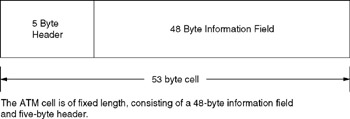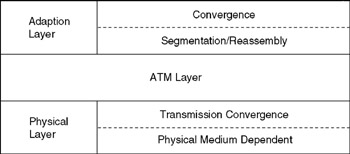2.4 ATM and the ATM Cell
2.4 ATM and the ATM Cell
Asynchronous Transfer Mode (ATM) represents a switch-based, connection-oriented technology. In this section we obtain an overview of ATM, which will provide a foundation for examining the overhead associated with the use of ATM cells in this chapter as well as a reference for developing performance models in later chapters.
2.4.1 The ATM Cell
ATM was developed as a transmission technology that can support both voice and data on a common network infrastructure. To accomplish this, ATM uses a fixed- size transmission unit known as a cell. The ATM cell is relatively short, containing a 48-byte information field and a 5-byte header. Figure 2.14 illustrates the basic composition of the ATM cell.

Figure 2.14: The ATM Cell
The selection of a relatively short 53-byte cell was based on the necessity to minimize the effect of data upon such time-dependent transmissions as voice and real-time video. For example, assume a variable frame length technology such as Ethernet or Token Ring is used. Then it becomes possible for a lengthy data transmission that fills a frame to its maximum length to gain access to a network between a sequence of digitized voice-filled frames. This action will delay the receipt of succeeding frames transporting digitized voice so that, upon their receipt, the converted voice sounds distorted by time. ATM is designed to eliminate such problems as cells are relatively short, thus resulting in cells transporting voice being able to arrive on a regular basis.
A second significant advantage associated with the use of fixed-length cells concerns the design of switching equipment. ATM logic can be developed as firmware embedded in hardware, enabling faster processing at a lower cost than if software was used to perform ATM operations.
In addition to its relatively short cell length facilitating the integration of voice and data, ATM provides three additional benefits. Those benefits are in the areas of scalability, transparency, and traffic classification.
ATM cells can be transported on LANs and WANs at a variety of operating rates. This enables different hardware, such as LAN and WAN switches, to support a common cell format, a feature lacking in other communications technologies. An ATM cell generated on a 25-Mbps LAN can be transported from the LAN via a T1 line at 1.544 Mbps to a central office. At that location, the cell might be switched onto a 2.4-Gbps SONET network for transmission on the communications carrier infrastructure, with the message maintained in the same series of 53-byte cells, with only the operating rate scaled for a particular transport mechanism.
Concerning transparency, the ATM cell is application transparent, enabling it to transport voice, data, images, and video. Due to its application transparency, ATM enables networks to be constructed to support any type of application or application mix instead of requiring organizations to establish separate networks for different applications.
2.4.2 Traffic Classification
Five classes of traffic are supported by ATM, to include one constant bit rate, three types of variable bit rates, and a user -definable class. As ATM standards were further developed, support for two traffic classes were merged together into a common ATM adaptation layer (AAL) protocol. Later in this section we discuss the role of the AAL and its support for different classes of traffic.
By associating such metrics as cell transit delay, cell loss ratio, and cell delay variation to a traffic class, it becomes possible to provide a guaranteed Quality of Service (QoS) on a demand basis. This enables a traffic management mechanism to adjust network performance during periods of unexpected congestion to favor traffic classes based upon the metrics associated with each class.
Quality of Service (QoS) is one of the key features of ATM; it enables the technology to provide a predefined level of support to different types of data streams. An endpoint requesting the setup of a connection through an ATM network can request a QoS from the network. Once granted, the endpoint will be assured that the network will provide the selected QoS for the life of the connection. The ATM Forum presently defines five traffic classes, which are summarized in Table 2.8. This table includes the type of each traffic class, a description of its intended use, and an example of its potential utilization.
| Traffic Class | Description |
|---|---|
| Continuous bit rate (CBR) | Constant bit traffic with a fixed timing relationship between data samples, such as an emulated voice circuit |
| Variable bit rate “ real-time (VBR/RT) | Variable bit rate traffic that has a fixed timing relationship between data samples, such as compressed video |
| Variable bit rate “ non-real -time (VBR/NRT) | Variable bit rate traffic that has no timing relationship between data samples but for which a guarantee of a QoS is required, such as Frame Relay |
| Available bit rate (ABR) | Variable data transmission that has no timing relationship and can be handled on a best-effort basis, such as electronic mail |
| Unspecified bit rate (UBR) | A class of traffic for which there is no service guarantee; the user can transmit any amount of data up to a specified maximum but the network does not guarantee delay or a cell loss rate |
As we probe further into ATM we will note that the only priority field within an ATM cell is used to indicate whether or not a cell can be dropped. Thus, the method used by an ATM network to provide a QoS is not priority based. Instead, it is based on a set of traffic parameters that define such metrics as the Peak Cell Rate (PCR), Cell Delay Variation Tolerance (CDVT), Sustainable Cell Rate (SCR), Burst Tolerance (BT), and Minimum Cell Rate (MCR). Only some of these metrics are applicable for certain traffic classes. For example, only the Peak Cell Rate, which specifies how often data samples are transmitted, and the Cell Delay Variation Tolerance (CDVT), which determines the amount of displacement of a signal from its intended location, are applicable for constant bit rate (CBR) traffic. Later in this section we examine the relationship between ATM adaptation layers , traffic classes, and traffic definition metrics.
2.4.3 The ATM Protocol Stack
Similar to other networking architectures, ATM is a layered protocol. The ATM protocol stack is illustrated in Figure 2.15 and consists of three layers: the ATM adaptation layer (AAL), the ATM layer, and the physical layer. Both the AAL and the physical layer are subdivided into two sublayers . Although the ATM protocol stack consists of three layers, as we will shortly note, those layers are essentially equivalent to the first two layers of the ISO Reference Model. However, because ATM possesses many of the characteristics of a layer 3 or network layer protocol such as a hierarchical address space and a complex routing protocol, some people consider it to represent a network protocol.

Figure 2.15: The ATM Protocol Stack
EAN: 2147483647
Pages: 111